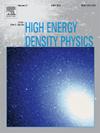计算不透明度的矩阵方法
IF 0.9
3区 物理与天体物理
Q3 PHYSICS, FLUIDS & PLASMAS
引用次数: 0
摘要
原子结构计算是不透明度计算的第一步。它们提供了评估斯莱特积分和偶极矩阵元素所需的自洽电子势和电子波函数。在本文中,我们展示了可以使用简单的矩阵方法在标准原子结构网格上进行哈特里-福克-斯莱特或 LDA 计算,包括相对论修正,得到约束波函数和连续波函数,这些波函数可以与统计展宽技术结合使用,以获得逼真的平均原子不透明度。本文章由计算机程序翻译,如有差异,请以英文原文为准。
Matrix methods for opacity calculations
Atomic structure calculations are the first step in an opacity calculation. They provide the self-consistent electronic potential and electron wavefunctions that are needed to evaluate the Slater integrals and dipole matrix elements. In this paper, we show that simple matrix methods can be used to perform Hartree–Fock–Slater or LDA calculations on standard atomic structure grids, including relativistic corrections, yielding bound and continuum wavefunctions that can be used, in conjunction with statistical broadening techniques, to obtain realistic average-atom opacities.
求助全文
通过发布文献求助,成功后即可免费获取论文全文。
去求助
来源期刊

High Energy Density Physics
PHYSICS, FLUIDS & PLASMAS-
CiteScore
4.20
自引率
6.20%
发文量
13
审稿时长
6-12 weeks
期刊介绍:
High Energy Density Physics is an international journal covering original experimental and related theoretical work studying the physics of matter and radiation under extreme conditions. ''High energy density'' is understood to be an energy density exceeding about 1011 J/m3. The editors and the publisher are committed to provide this fast-growing community with a dedicated high quality channel to distribute their original findings.
Papers suitable for publication in this journal cover topics in both the warm and hot dense matter regimes, such as laboratory studies relevant to non-LTE kinetics at extreme conditions, planetary interiors, astrophysical phenomena, inertial fusion and includes studies of, for example, material properties and both stable and unstable hydrodynamics. Developments in associated theoretical areas, for example the modelling of strongly coupled, partially degenerate and relativistic plasmas, are also covered.
 求助内容:
求助内容: 应助结果提醒方式:
应助结果提醒方式:


